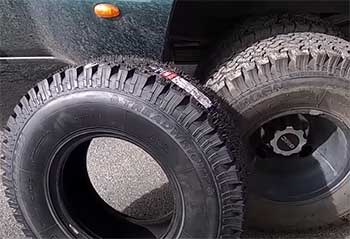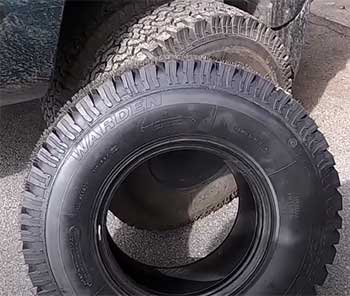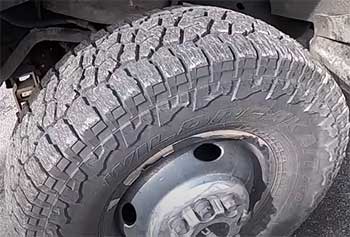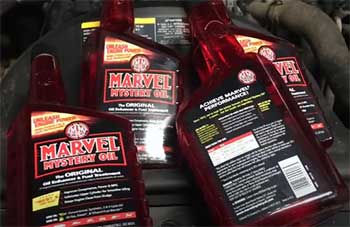TreadWright tires have become a popular budget-friendly option for drivers looking to replace their tires in recent years. However, some drivers have reported experiencing problems with TreadWright tires, ranging from tread life issues to ride quality concerns.
In this comprehensive guide, we’ll explore the most common TreadWright tire problems reported by drivers to help you make an informed decision when considering these retreaded tires.
Common Problems With TreadWright Tire
While many drivers have had positive experiences with their TreadWright tires, problems have also been reported by some owners. Here are some of the most common issues with TreadWright tires based on customer reviews and forum discussions:
- Short Tread Life

One of the most frequently cited complaints about TreadWright tires is that tread life falls short of expectations and advertised mileage claims.
Some owners report getting as little as 20,000 miles before needing replacement, even when rotating regularly.
This is well short of the 40,000+ miles many expect from their tires.
Factors that can contribute to accelerated tread wear include the retread process limitations, tire maintenance and inflation issues, and driving habits. The casing quality and condition also plays a role. Still, many feel tread life should exceed 20-25k for a quality retread tire.
- Ride Quality Issues
Ride quality is another common complaint among TreadWright owners. Some report the tires produce noticeable vibration at highway speeds, wander on the highway, are noisy, or feel overly stiff.
These ride quality complaints suggest the precision of the retread process may not match that of new tire manufacturing. Factors like casing condition, tread rubber bonding, and balance can affect ride feel. Many note the tires smooth out somewhat after a break-in period.
Also Read: Problems With Westlake Tires.
- Traction Problems
Traction in wet and wintry conditions is another issue cited by some TreadWright owners. There are reports of the tires slipping on wet pavement making hard acceleration or braking difficult.
Others mention poor performance in snow and ice leading to getting stuck or sliding into curbs.
The tread compound durability and groove design may not provide the grip of a high-end new tire in some conditions. Extra care is required when accelerating, braking, and cornering in low traction situations.
- Tread Separations

A very concerning problem reported by some TreadWright owners is actual tread separation from the casing.
This can happen when the bond between the new tread rubber and casing fails, causing the tread to peel away.
This leads to immediate loss of traction and potential blowouts when separations occur at speed.
Manufacturing defects, improper bonding procedures, and casing condition mismatches can all contribute to tread separations.
When bonding and casing prep is not done meticulously, the results can be hazardous tread separation failures. These situations can endanger drivers when occurring at highway speeds.
- Casing Quality Concerns
Since TreadWright tires use old casings, casing condition is a common concern. Some owners report sidewall cracking, bulging, casing damage, or failures originating from the old casing. Irregular wear patterns also suggest some casings are not ideal candidates for retreading.
TreadWright states they carefully inspect all casings for retread suitability. However, some compromised casings likely still get through inspection and manifest problems later on. Ensuring casing integrity and matching casing condition to application is vital for retreads.
- Balance and Vibration Issues
Proper tire balance is critical, especially at highway speeds. However, some TreadWright owners complain about persistent vibration issues even after rebalancing. This suggests the retread bonding process itself may lead to intrinsic balance problems in some cases.
Careful inspection of the tread surface and inner casing appearance is advised when balance issues arise. Any noticeable tread rubber cracks, bonding irregularities, or casing damage found requires the tire be replaced immediately.
- Batch Inconsistencies

Another issue often noted in reviews is inconsistency between different batches of tires.
When replacing just two tires, owners sometimes report the new and old tires feel completely different during use.
This suggests potential issues with quality control consistency across different batches of retreaded tires.
New tread rubber formulas, bonding agent batches, and workers likely vary, leading to inconsistencies owners notice on the road.
- DOT Code Issues
TreadWright has received criticism regarding their DOT tire code format on some tires. Instead of the standard 4 digit DOT code following by the 4 digit date code, some tires had only a 5 digit code or other anomalies.
This led to questions about whether some tires lacked the DOT stamp certifying compliance with FMVSS regulations. TreadWright addressed the issue in 2018, blaming a misunderstanding with NHTSA guidelines. They reaffirmed all their tires are fully DOT compliant.
- Limited Warranty Coverage
Finally, TreadWright tires only come with a basic warranty that covers defects for the first 2/32nds of tread wear. Some owners felt the warranty should be more generous given the premium pricing of TreadWright tires versus other retreads.
Competitors like Marastar offer full-workmanship warranties against any defects for the usable tread life. TreadWright’s warranty requires owners pay a pro-rated price for replacements after the minimal coverage expires. Expanding the warranty terms could give customers more peace of mind.
Also Read: Complaints Against Douglas Tires.
Factors To Consider with TreadWright Tires
Based on the common problems reported by owners, here are some important factors to keep in mind if considering TreadWright tires:
- Tread Life Variability – Treadwear can vary widely based on driving conditions, maintenance, and casing quality. Consider maximum mileage estimates optimistically.
- Casing Condition – Ask for evidence of rigorous inspection and casing selection standards. Avoid any signs of damage or deterioration.
- Application Matching – Ensure the tire model aligns with the vehicle weight, capacity, speeds, and usage.
- Rotations & Maintenance – Follow a diligent rotation schedule and check inflation and alignment frequently per manufacturer recommendations.
- Road Conditions – Understand traction limitations in wet weather, snow, and ice. Adapt driving accordingly in low grip situations.
- Speed Ratings – Do not exceed the tire speed rating for prolonged periods to avoid overstressing the casing.
- Warranty Details – Review what is covered under warranty and the pro-rated replacement fees. Retread warranties are often limited.
- Professional Installation – Have a reputable shop thoroughly inspect each tire during mounting for any issues.
Retread Tires – Myths vs Facts
There are also some common misconceptions about retreaded tires that are important to clear up:
Myth: Retreaded tires are unsafe.
Fact: When properly manufactured, retreads must still pass all DOT safety standards like new tires. Brands like Marastar retreads have excellent safety records over decades of use.
Myth: You don’t know the history of a retread’s casing.
Fact: Reputable retreaders only select casings with verifiable histories and rigorous inspection analysis. Unknown history casings should never be used.
Myth: Retreading compromises the casing over multiple cycles.
Fact: With proper selection and processes, casings can safely support two retread cycles before replacement. Major fleets regularly run retreads this way.
Myth: Retreads don’t perform as well as new tires.
Fact: With today’s technology, the difference in tread compound and tread pattern performance is minor between quality retreads and budget new tires.
Myth: Retreads are only good for the drive axle.
Fact: Modern retreads can reliably be used on steer axles as well, though extra casing scrutiny is advised. High quality retreads steer just fine.
Knowing the facts on retreaded tire performance and safety can help drivers feel confident choosing a quality product like Marastar or TreadWright. While no tire is perfect, they can provide a substantial value advantage over new when produced properly.
Also Read: Complaints Against Tire Linc.
Frequently Asked Questions (FAQ)
Treadwear for TreadWright tires can vary substantially based on model, driving conditions, maintenance and care, and casing quality. The company estimates a tread life of 40,000-50,000 miles for most tires when properly rotated and inflated. However, actual driver experiences vary widely from as little as 20,000 miles to over 40,000 miles in real-world use. Take their mileage estimates optimistically and monitor tread depth closely as the tires wear.
Quality remolded tires from reputable brands that follow rigorous manufacturing and casing standards can certainly be safe replacements for factory new tires. Brands like Marastar have decades of commercial use proving retreads can perform well and safely when proper processes and materials are used. However, remolded tires do demands some added owner diligence to ensure casing condition, maintenance, speeds, and loads are all within safe parameters for the application.
Yes, Treadwright confirms that all their retreaded tire models meet DOT safety standards and come with proper DOT serial number branding. In 2018, there was some confusion around their DOT code format on some tires based on a misunderstanding of the NHTSA rules. But TreadWright has clarified that their tires comply with DOT regulations and standard date code formats.
A remolded tire refers to a previously used tire casing where the old worn tread has been buffed away and new tread rubber has been bonded to the prepared casing. This remanufacturing process is known as tire retreading or recapping. When done properly on suitable casings, retreading provides a lower cost alternative to new replacement tires. Major commercial fleets routinely run vehicles on retreaded tires to save on operating costs while still maintaining safe operation.
Final Thoughts
In summary, TreadWright tires can offer notable value but also come with inherent compromises versus new tires. Owners report issues like shorter than expected tread life, ride quality complaints, traction limitations, and tread bonding problems in some cases.
However, when selected and maintained properly for the intended application, many find TreadWright tires provide satisfactory budget-friendly performance.
Understanding the key factors involved, realistic expectations, proper tire care, and diligent condition monitoring are advised for buyers considering TreadWright retreaded tires. Weigh the benefits and potential drawbacks closely for your own situation before deciding.

